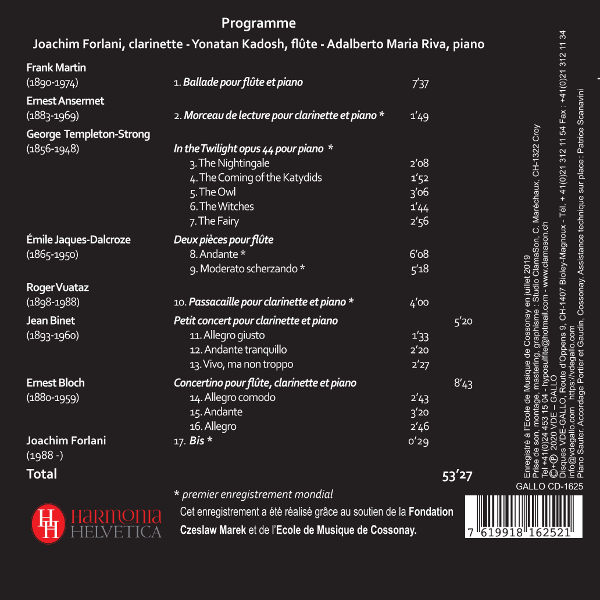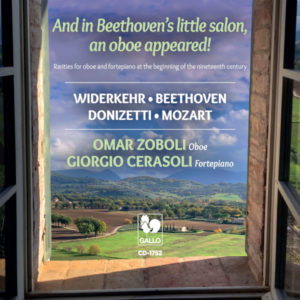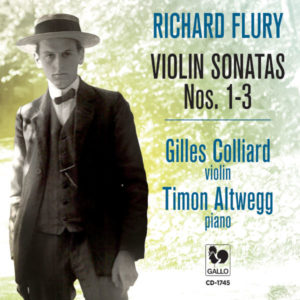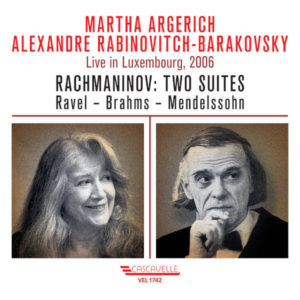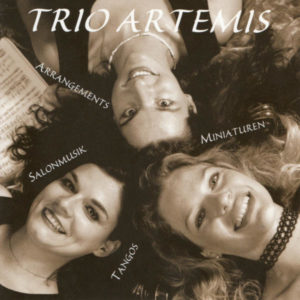Extraits / Excerpts
SCHWEIZER MUSIK DES 20. JAHRHUNDERT - FRANK MARTIN : BALLADE - ERNEST ANSERMET : MORCEAU DE LECTURE - ERNEST BLOCH : CONCERTINO... - JOACHIM FORLANI - YONATAN KADOSH - ADALBERTO MARIA RIVA
Schweizer Musik des 20. Jahrhundert
Frank MARTIN : Ballade pour flûte et piano – Ernest ANSERMET : Morceau de lecture pour clarinette et piano – George Templeton STRONG : In the Twilight, Op. 44: No. 1 The Nightingale – No. 2 The Coming of the Katydids – No. 3 The Owl – No. 4 The Witches – No. 5 The Fairy – Émile JAQUES-DALCROZE : Deux pièces pour flûte: I. Andante – II. Moderato scherzando – Roger VUATAZ : Passacaille pour clarinette et piano – Jean BINET : Petit concert pour clarinette et piano: I. Allegro giusto – II. Andante tranquillo – III. Vivo, ma non troppo – Ernest BLOCH : Concertino for Flute Clarinet and Piano: I. Allegro comode – II. Andante – III. Allegro – Joachim FORLANI : Bis.
Joachim Forlani, Klarinette (Web Site) – Yonatan Kadosh, Flöte (Facebook) – Adalberto Maria Riva, Klavier (Web Site).
Schweizer Musik des 20. Jahrhundert – Solo – Duo – Trio
Wind playing in Romandy (French-speaking Switzerland) is closely related to the development of brass bands and wind bands in the second half of the nineteenth century. Nonetheless, teaching of these instruments at conservatories – woodwind and brass instruments alike – did not develop until after the First World War.
Since the foundation of the Orchestre de la Suisse Romande, Ernest Ansermet secured the services of virtuoso musicians, trained at the Paris or Brussels Conservatoires, who in their capacity as professors applied a genuine professionalism to conservatory classes in Romandy. Like their colleagues all over Europe, where music for wind instruments became more common from the 1920s onwards, Swiss composers would contribute to a repertoire that would blossom with the spread of the neo-classical aesthetic and the taste for
forthright timbres and rhythms that was prevalent at the time. In fact, although composers before the First World War – with the notable exception of figures such as Hans
Huber or Joseph Lauder – were rarely inspired by wind instruments, works for brass and (especially) woodwind would soon proliferate, by young composers from Romandy and Germany.
In addition, Henri Gagnebin and Frédéric Liebstoeckl, who founded the Geneva International Music Competition (Concours International d’Exécution Musicale de Genève) in 1939, decided that every competitor would have to perform a compulsory piece, preceded by a sight-reading test – both pieces commissioned from Swiss composers. This initiative enriched the wind repertoire with many remarkable works. The present recording offers proof of this, at the same time letting us discover piano works by two of the key musical figures in Romandy, George Templeton-Strong and Émile Jaques-Dalcroze – the latter a brilliant teacher: all the other composers represented on this disc were his pupils.
Jacques Tchamkerten
- Kategorien
- Komponisten
- Interpreten
- Booklet

